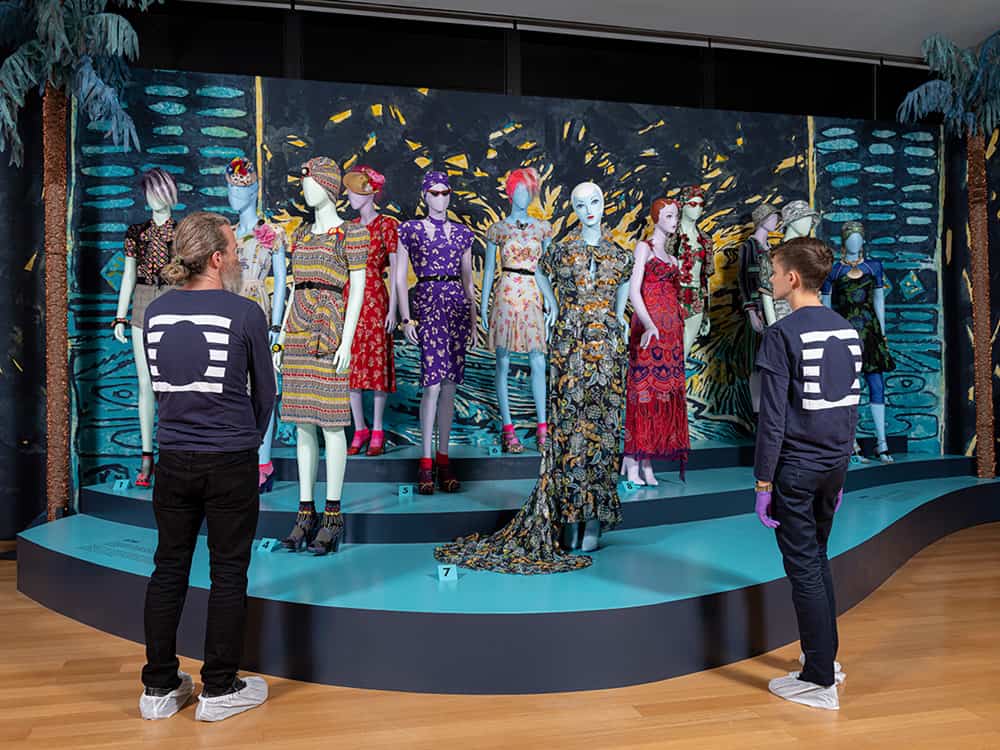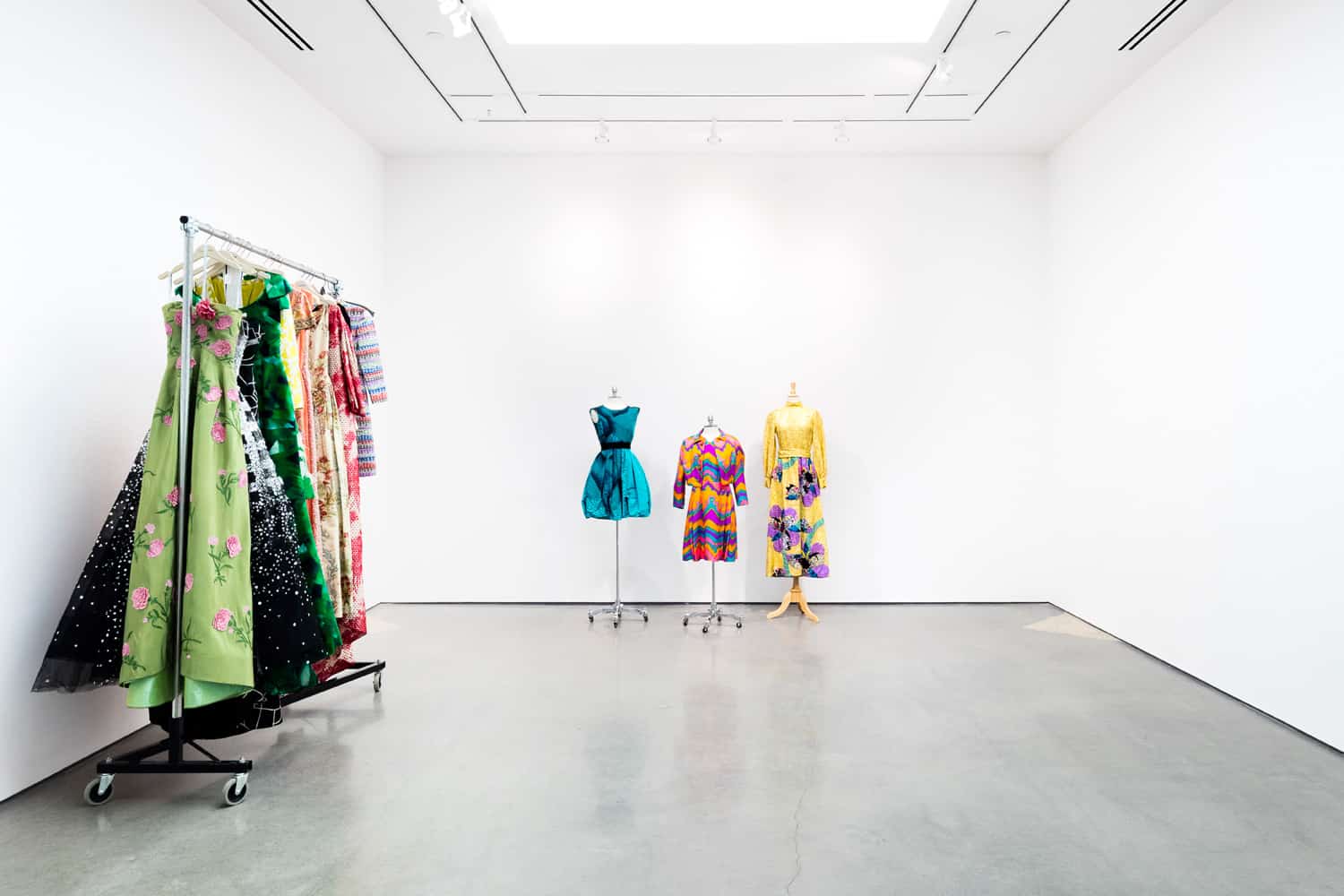Uovo has been NYC’s premiere art storage facility since opening its first location in 2014. With its sophisticated look and next-level storage functions, it’s nabbed the attention of chic clotheshorses, too — and in early 2019, Uovo officially launched a branded fashion arm, MODA. Kelsey Rudin, Uovo’s EVP of finance and business management, and Anne Maso, director of marketing and communications, explain what makes MODA a fashion archivist’s paradise.
Why has fashion archiving become so popular?
Kelsey Rudin: With the Alexander McQueen exhibition at the Met, you started to really see an interest and appreciation in preserving fashion, and seeing those cultural collections as part of our legacy. [There’s an] understanding that to have these museum shows, to investigate what our past looks like through design, we need to preserve those pieces… “Heavenly Bodies” at the Met had the highest visitor rate in its history, [nearly] 1.7 million visitors. I don’t know whether anyone could have anticipated the interest in seeing fashion collections amongst the public. What’s exciting about what we’re doing is that we’re addressing needs and preempting some of those needs as well.
Was MODA always part of Uovo’s plan?
RUDIN: We really transformed the way people use and view art storage, and the expectation for it. We have a hospitality approach to the service; people can come into the spaces, use the viewing galleries, and use their own rooms. They can not only store but interact with their collections. Realizing how similar art and fashion are in terms of care — the need for climate control, UV protection, etc. — we’ve been quietly working with designers, entertainers, and collectors of fashion since we opened. It got to the point where it felt like we should be talking about fashion the way we talk about art.
Is the care of art and fashion pieces really all that similar?
RUDIN: Our staff is highly trained to handle incredibly fragile, expensive, and monumental pieces of art; there’s a similar application. The care and attention to detail in the handling and transport [is also similar]. Also, what’s unique about us is we maintain our objectivity. If a fashion brand has a team of archivists and curators they like to work with, they can work in our space, as long as they’re authorized by that brand. They can rent our viewing rooms, or the client might have their own space. We also have partners we refer, and we have a fashion archiving partner in particular.
How do you go about finding an archivist?
Anne Maso: We’re lucky because we work with the best. I don’t think it’s any exaggeration to say the premier conservators in the world are coming here to work. It’s an extension of who we are. Our network is deep.
Any predictions about the future of fashion and art storage?
RUDIN: Sustainability is such an important conversation that’s more present than ever. That really connects to what we’re doing with fashion archiving. Less is more these days. Vintage and resale are increasingly appealing to consumers. There’s a growing appreciation for vintage, and for things that are really well made. So how do we sustain that? How do we allow them to grow? How do we reference the way things were made in the past so they endured, as opposed to the current trend of fast fashion?
Does the building itself have any sustainability initiatives?
RUDIN: Yes. A lot of our building methods are green. And we recycle.
MASO: That’s been an exciting innovation, actually — we’ve moved to all-recyclable gloves! It’s an amazing transition and helps with the waste from this industry. We’re excited to be part of the effort to tackle that and make the switch.
How else have you modernized?
RUDIN: Digital interfaces are such a big part of our lives. People can go on their phones and look through their inventory — we can scan everything digitally. We’re keyless; we can track everything remotely. That we can work in this really remote, flexible, and technologically savvy way is unique and also at the forefront of what people are looking for in their experiences.
Sounds high-tech!
RUDIN: This facility is the first-ever purpose-built facility in the U.S. for the care of fine-art collections and design. Another thing is optimizing for disaster preparedness. It was built post–Hurricane Sandy, and has double redundancy in terms of generators. You want to be in a space that is built to protect against fire, flood, and other natural disasters. We’re built outside the FEMA flood zone. We’re 16 feet above sea level. We were vetted by all the world’s leading insurers, including AXA GRASP [Global Risk Assessment Platform]. We use fireproof materials, and we install the most sophisticated HVAC and security systems.
What can you offer a private collector?
MASO: What’s really going to [harm] all materials is fluctuation. When you’re [a fashion lover], and you have beautiful gowns, you want to take care of them. But you’re not wearing them all the time. They’re taking up space. We can offer a place to put those pieces where there are no fluctuations. The furs, the feathers — all those materials are kept stable. That’s the key. When you do want to wear things, you call, we’ll send it to you or you come in to your private room and you grab it. And you have it exactly when you need it in that museum environment, so it’s still in perfect shape years later.
RUDIN: Also, we have options starting at $250 a month. It isn’t just for larger collections — it really is for everyone. We’ve created a system and amassed real estate that allows us to offer space for collectors at every budget and every need.
When things are in transit, how do you ensure the same level of climate control?
RUDIN: We have a fleet of 10 custom-built, climate-controlled trucks. People are lending out of here all the time.
Any super old couture pieces in house?
RUDIN: Discretion is of most importance; we don’t necessarily know everything we have. [But] we’re aware of a few amazing vintage libraries that are stored in our facilities. We have pieces that are at least 100 years old. I think there are many treasures here.
Why the secrecy? What type of things would a client want to be private about?
RUDIN: There are many reasons that drive people. For example, entertainers have large fashion archives, and there’s a privacy component with a lot of their work. There may be things that [designers] don’t want to be seen, at least until the collection is shown. A lot of brands are using the archives as an inspiration library. In order to maintain that brand heritage, it’s important that new designers are up to speed with past designs. Sometimes they’ll use them as reference, or even just getting to see and touch the materials.
Good as New
Julie Ann Clauss, founder of fashion archiving firm The Wardrobe and UOVO: MODA’s fashion archiving partner, explains the ins and outs of collecting clothing.
What are some common environmental factors that cause wear and tear to clothes?
Not cleaning them properly. While you don’t want to dry-clean clothes more often than necessary, you have to clean clothes before you store them. You may not notice you dropped a small bit of food on your garment, and be tempted to store it thinking it seems clean. If not treated, a stain can appear over time. Not only will it be much more difficult to remove later, but it will also attract pests that could further damage it.
What are the dos and don’ts of archiving clothing?
It’s important to know when something must be packed flat, and when it’s okay to hang it. Flat packing does not mean folding something up in a drawer. It should be professionally done using the appropriate archival materials. Exposure to light is also a big no-no. Once a garment has what we call “light fugivity,” there’s nothing you can do for it. You’ll often see the shoulder line of a vintage dress is lighter than the rest due to UV exposure. Keeping things at the right temperature and humidity level is really important for long-term storage. When it comes to clothing, prevention is truly better than a cure.
What’s the most challenging repair you’ve handled?
Getting perspiration out of garments is a true challenge, and it’s something we always have to contend with. The truth is that your average dry cleaner doesn’t know how to do this, and doesn’t even attempt it. That’s why most clothing comes back from the cleaners with a stale smell.
What’s the oldest garment you’ve ever worked on?
|I once hand-washed a silk piece from the early 1800s.
Any celebrity pieces you would love to work with?
The nexus of music and fashion is what most interests me. I would love to get my hands on Cher’s and Lady Gaga’s archives!
Subscribe to our newsletter and follow us on Facebook and Instagram to stay up to date on all the latest fashion news and juicy industry gossip.







